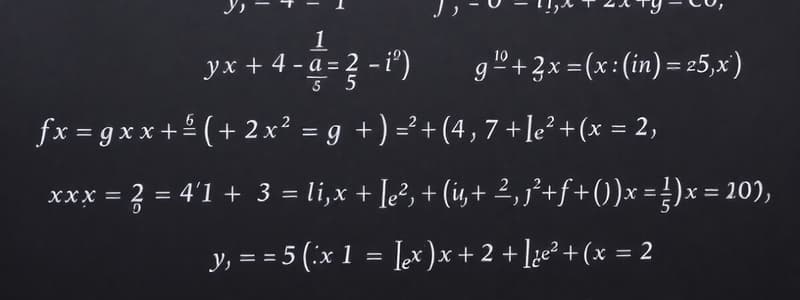Podcast
Questions and Answers
Which property states that the grouping of elements does not affect the result of an operation?
Which property states that the grouping of elements does not affect the result of an operation?
- Identity property
- Associative property (correct)
- Commutative property
- Distributive property
Which of the following is a characteristic of a function?
Which of the following is a characteristic of a function?
- It cannot be a linear relation
- Every input has a unique output (correct)
- It must be represented graphically
- An output can have multiple inputs
In a system of equations with three variables, what is the potential outcome if the equations are dependent?
In a system of equations with three variables, what is the potential outcome if the equations are dependent?
- Infinitely many solutions (correct)
- Three unique solutions
- One unique solution
- No solutions
What is the result of multiplying a matrix by a scalar?
What is the result of multiplying a matrix by a scalar?
Which method can be used to factor the expression $x^2 - 9$?
Which method can be used to factor the expression $x^2 - 9$?
When converting a quadratic equation from standard form to vertex form, which of the following represents the vertex?
When converting a quadratic equation from standard form to vertex form, which of the following represents the vertex?
What does the discriminant of a quadratic equation indicate?
What does the discriminant of a quadratic equation indicate?
Which operation is NOT valid for a matrix with dimensions 2x3 and a matrix with dimensions 3x2?
Which operation is NOT valid for a matrix with dimensions 2x3 and a matrix with dimensions 3x2?
Flashcards
Set
Set
A collection of well-defined objects.
Associative Property of Addition
Associative Property of Addition
The property that states the order in which numbers are added doesn't change the sum. Example: (a + b) + c = a + (b + c).
Rational Number
Rational Number
A number that can be expressed as a fraction, where the numerator and denominator are integers.
Function
Function
Signup and view all the flashcards
Domain of a Function
Domain of a Function
Signup and view all the flashcards
Solving Linear Equations
Solving Linear Equations
Signup and view all the flashcards
System of Equations
System of Equations
Signup and view all the flashcards
Matrix
Matrix
Signup and view all the flashcards
Study Notes
Unit 1
- Classify collections of elements as sets or non-sets.
- Use field axioms (associative, distributive, commutative properties).
- Identify whether numbers belong to specific number sets (integers, natural numbers, rational numbers, irrational numbers, real numbers).
Unit 2
- Determine if a relation is a function using different representations (graphs, tables, equations, mapping diagrams).
- Identify the domain and range of a function.
- Solve linear equations and absolute value equations.
- Apply transformations (graphically and algebraically) to linear, quadratic, and absolute value functions.
- Evaluate compositions of functions (numerically and algebraically).
- Find the inverse of a function algebraically.
Unit 3
- Solve systems of equations in two variables (involving two linear equations).
- Solve systems of equations in three variables.
- Use systems of equations to model and solve real-world applications.
Unit 4
- Perform addition and subtraction of matrices.
- Perform multiplication of matrices.
- Perform multiplication of a matrix by a scalar.
- Determine if a matrix operation is possible.
- Find the inverse of a 2x2 matrix.
Unit 5
- Calculate the determinant of a 2x2 matrix.
- Write a system of equations as a matrix equation.
- Model real-world applications with matrices.
- Factor quadratic expressions (using various methods).
- Factor expressions using difference of squares and grouping.
- Use completing the square with quadratic equations and expressions.
Unit 6
- Convert between standard and vertex forms of quadratic equations.
- Apply vertical and horizontal translations to quadratic functions.
- Apply reflections and dilations to quadratic functions.
- Understand the relationship between the discriminant and types of zeros of quadratic functions.
- Find the equation of a quadratic function given its key features (vertex, axis of symmetry, intercepts).
- Describe characteristics of quadratic functions.
- Graph quadratic functions.
- Find the zeros of quadratic equations (when real or non-real).
- Add and subtract complex numbers.
- Multiply complex numbers.
- Divide complex numbers and write in a + bi form.
- Plot complex numbers on a complex plane.
- Calculate the modulus of a complex number.
- Understand complex numbers and "i".
Studying That Suits You
Use AI to generate personalized quizzes and flashcards to suit your learning preferences.



